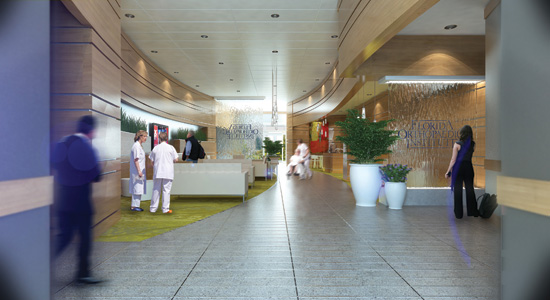This CE Center article is no longer eligible for receiving credits.
Designing for Sustainability and Performance
Another incredibly valuable aspect of BIM is the ability to run performance simulations of a particular building design or variation. The better the performance as determined by simulations, then the more sustainability that usually results in the final design. This is particularly true in terms of how a building can be expected to perform over its useful life, including how much energy is required to operate it. All building designs, new or renovation, are being driven to meet the challenge of reduced energy consumption and greater sustainability whether driven by large-scale environmental concerns, energy codes, or economic concerns by owners on the cost of energy. In response, designers who recognize and use this simulation capability can readily make sound decisions regarding the performance of a building in terms of things like energy usage, lighting, etc.
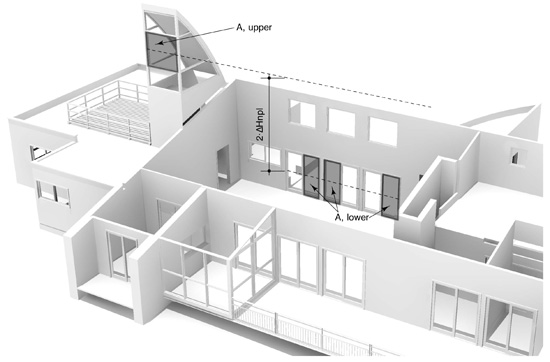
Image courtesy of François Lévy
A very valuable aspect of BIM is the ability to run performance simulations of a particular building design or variation, particularly for determining energy consumption comparisons. In this model, a stack-effect calculation has been integrated in BIM with a worksheet that responds dynamically to changes in aperture sizes and relative heights, automatically providing an updated airflow rate estimate.
According to the not-for-profit organization Architecture 2030, the largest impact on energy reduction comes about by the design of a building, not by adding technology. In particular, designs that acknowledge the influence of the natural site elements (sun, wind, weather, etc.) on the building's energy use patterns and use a building envelope (walls, roof, floor) to either allow or restrict those natural elements into the building can have huge impacts on energy use. BIM can play a key role in determining those impacts from the earliest design phases, as well. Simulated designs can be compared against performance standards such as the U.S. Green Building Council's LEED program, the ENERGY STAR for buildings program, or Passivhaus for residential design. Software, either within a BIM model or run separately, can account for the path of the sun, the annual weather / climate patterns, the amount of wind, and other onsite factors as they affect a building. Software can also account for the usage patterns, internal energy demands, and human factors that drive the need for energy for HVAC, lighting, or operations. Relying again on parametric design, a designer can alter a detail such as the window to wall ratio on a façade, change the orientation of a building on a site, or minimize the external surface area, and see the relative impact on energy usage each time because of that change. This information can then be used to make design decisions to optimize the building performance for energy usage while also informing other criteria for size, cost, or other factors.
François Lévy has built his Austin, Texas practice Lévy Kohlhaas Architecture around this marriage of BIM and sustainability. He describes his work as “buildings that capture the imagination, express regional beauty and a sense of place, and sit lightly on the earth.” His work investigates the intersection of design, technology, and sustainability with a particular passion about working collaboratively to create buildings that eloquently express how to use and conserve energy and water, and inhabit the land. Moreover, he asserts that “BIM offers architects a rich opportunity to validate qualitative design decisions with early quantitative analysis. When the 3D geometry and intelligence of BIM are at the service of sustainable design, architects can use green design goals as a fertile context to design buildings that are both beautiful and responsive to their climates.” Lévy's projects have attracted regional and national press, including HGTV, Dwell, This Old House, and Natural Home magazines. He has also authored a book titled BIM in Small-Scale Sustainable Design,2 which is unique in its clear procedures for designing sustainable, climate-load dominated buildings within a BIM workflow. As a resource for design professionals, the book addresses the latest technological tools in BIM, sustainable design, and integrated practice. It covers a range of topics including passive cooling and heating, building hydrology, optimizing material use, reducing construction waste, and collaboration within teams of building design professionals.
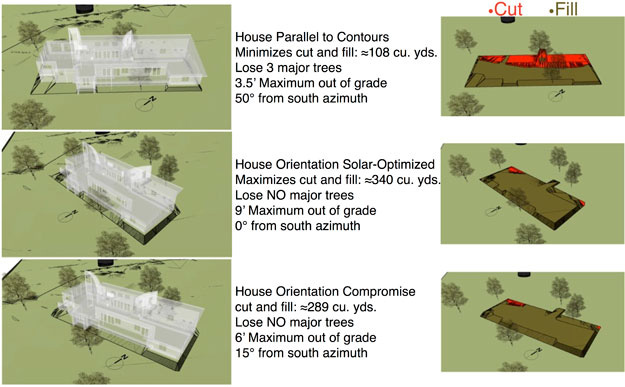
Image courtesy of François Lévy
Using BIM software tools, two competing design criteria of minimizing impact on the site while maximizing the shading effect and solar PV collection of the roof were studied in a series of simulations to determine the best sustainable performance outcome.
Lévy also advocates the leveraging of the quantitative information inherent to BIM to better inform the architect's qualitative design decisions. For example, he designed a residence on a 15-acre site in rural Texas, orienting the house on a dominant east-west axis to maximize solar gain control with a roof pitch and azimuth that are close to optimal for solar photovoltaic (PV) cells. A curved and formally expressive south-facing thermal chimney provides effective passive ventilation. The house's orientation, refined to allow all the nearby trees to thrive, coupled with a requirement of a step-less interior, was somewhat at odds with the site's topography: one end of the home was forced six feet above grade. Here, intelligent BIM software tools were used to support the architect in negotiating two competing agendas: minimizing impact on the site while maximizing the shading effect and solar PV collection of the roof. A series of simulations and BIM studies demonstrated how alternative orientations could be tested with the BIM software's intelligent site model tool and evaluated against a previously established ideal orientation from BIM solar animations. Ultimately, Lévy settled on a design that balanced site considerations and solar performance, informed by BIM's quantitative analysis capabilities.
What does an architect do? Many architects contend that the general public and indeed some clients don't really know since they often answer that question in limited terms of “design buildings” or simply “do the drawings.” Those within the profession or those engaged with building design on a more regular basis understand a broader scope of an architect's activities ranging from feasibility/programming work, to information analysis, design synthesis, construction documentation, construction oversight, and even facilities management interface. Of course, not all architects do all the same things since they are quite good at adapting and adjusting to the specific needs of clients, employers, projects, locations, or work processes. There is also a big difference between working for a series of unique clients, each with a single project such as churches or museums, compared to working with an ongoing, repeat client to produce dozens of projects over time such as retail or hospitality facilities. Some architects don't work in traditional firms; rather, they apply their talents within organizations such as government agencies, commercial corporations, non-profit entities, or educational institutions. And of course, not all projects developed, regardless of the owner, are new buildings since a majority of design and construction work in the United States is focused on the renovation of existing buildings. Despite all of these differences and variables, there is one thing that all design professionals have in common—namely, engaging in a process with building owners and other professionals to create a design, whether simple or complex, that becomes the basis for construction work to take place and the design to become a reality.
The Design Process
What is the design process? The answer to that question is about as individual and personal as they come. Different design professionals will have different starting points. Some will begin with information and data, others will start with an intuitive approach, and still others may use an external inspiration. The methodology to develop a design is also varied and often quite personalized. Some use words and numbers while others choose pencil drawings, cardboard models, computer software, or a combination thereof. Some assume that many different design options need to be looked at while others limit themselves to a preferred concept and develop it in detail from there. Hence, it is easy to see why the actual design process varies between firms or organizations and even among people within those organizations.

Image courtesy of GRO Architects, PLLC
New York City-based GRO Architects is using building information modeling (BIM) to design the CNBM World Headquarters building in Bengbu, China. They are among a growing number of firms that are using BIM from the earliest stages of design through construction.
Adding to this mix of variables in the process is the latest advancement in design resources available, namely building information modeling (BIM). While much has been written and many people have been involved in creating and using BIM tools for the past few decades, there are still a number of misperceptions about what it is and how it fits with the process of design and construction. Those who are able to set aside preconceived notions and open up to the possibilities that BIM provides as a genuine design tool can discover transformative ways to look at what architects do and find truly exciting new options for creative solutions that may not have been thought of before.
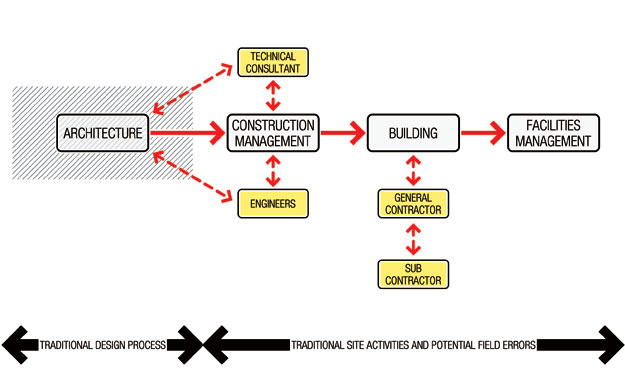
Image courtesy of Richard Garber, AIA, and GRO Architects, PLLC
The traditional, 20th-century process of design and construction typically separated the architects from the contractors and in many ways diminished the role of the architect.
BIM and Design
Among the professionals who have studied the full potential and promise that BIM holds for architects, Richard J. Garber, AIA, director of the School of Architecture at New Jersey Institute of Technology (NJIT), is noteworthy. Beyond his impressive academic career focused on building sciences and green architecture, he is also a practicing architect and principal in the New York City-based firm of GRO Architects, PLLC, allowing him to experience both the real-world issues of running a firm in addition to researching the trends and experiences of other firms around the globe. He has recently authored a book, published in England, titled BIM Design – Realising the Creative Potential of Building Information Modelling.1 In this work, he confronts the role of architects and others in the design and construction process. He points out that the typical 20th-century architect became increasingly separated from the construction process as new professions of construction managers and owners' representatives began to take on leadership roles previously enjoyed by architects. Accordingly, architectural offices became places where drafting tables were the primary workstation, and a hierarchy of designers, managers, and draftsmen produced 2D representations of buildings on linen, paper, or Mylar media. Some design professionals had limited exposure to the on-site construction processes or the people involved in the fabrication of products, materials, or construction of the building.
Garber points out that this separated role of the architect is in sharp contrast to the historical role of being the “Master Builder” who was responsible not only for the design but for the execution of the construction through to completion, as well. In some locations, the emergence of “design-build” firms has sought to reclaim this Master Builder role although there is certainly a mix of results on that front. In some cases, architects have been the leaders of the design-build process while in other cases they act essentially as subcontractors to a construction firm. Furthermore, in some parts of the United States, licensing laws and design-build legislation have severely limited an architect's role in design-build projects.
Nonetheless, there remain many architects who care deeply about construction as the actualization of their design work. They understand that successful designs rely on a real knowledge of materials, products, fabrication processes, and construction assembly techniques. They also acknowledge that new versions of all of these things are constantly being developed, requiring the input of specialists focused on particular aspects of a building.
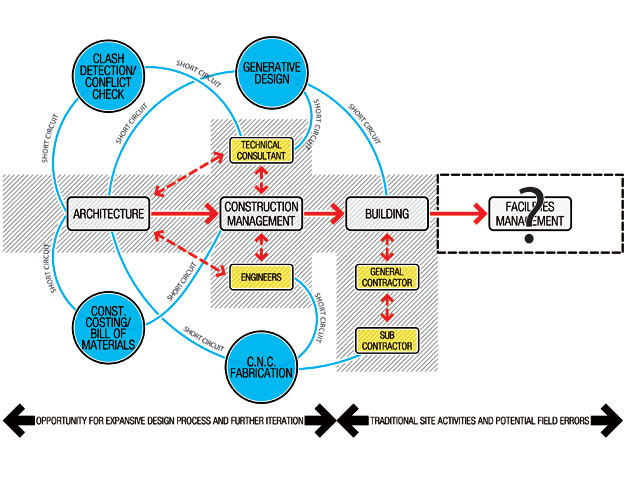
Image courtesy of Richard Garber, AIA, and GRO Architects, PLLC
In a 21st-century practice, the use of BIM allows for a more coordinated and integrated team that embraces and facilitates a truly iterative design process.
What does all of this have to do with the design process? Garber asserts that computerized building information modeling allows the architect to use new tools to re-connect design directly with the construction process and regain the lead role in the overall process. It is significant to note that he uses the word “modeling” rather than the word “model.” Modeling is a verb indicating an ongoing activity that starts with the very beginning of the design process and carries all the way through construction and even facility management. Model is a noun and refers to one of multiple outputs of the modeling process. This is not unlike thinking about the difference between using the word “drawing” as a noun or a verb. Drawing as an action is what architects and draftspersons are known to do as an ongoing process to explore, alter, and ultimately produce a final design. A drawing, used as a noun, is the output of the process of drawing. Hence, the first thing an architect needs to understand about realizing the full potential of building information modeling is that it should be regarded as an active process and not a static output. Further, as a fully customizable process, it is entirely adaptable to meet the personal design process of virtually any firm or individual. There is no one BIM process any more than there is only one drawing process.
Linear Versus Iterative Design
Richard Garber and others have noted that even though there are many variations on design process, it is not a truly linear thinking exercise. While there is an order to the process, it does not necessarily follow that it begins with site design, moves to foundation and structure, then to the building envelope, and on to the interiors, although the information outputs may be presented that way. Rather, it is more likely that any of these aspects of the design are being worked on at any time, testing different concepts or ideas, receiving feedback on what works well and what doesn't, refining the concepts, or moving on to entirely different ones. That process of repeating by trial and error, hypothesize and test, design and assess, is referred to as an iterative process. The best design results often come about when a design team employs that back and forth workflow or learning from different iterations of a design. Each bit of feedback informs the overall design so that intelligent decisions can be made about how to improve, refine, alter, or abandon a particular design, at the overall level or the detail level. This is true whether geometric form is being pursued or the functional performance of the structure, building envelope, or mechanical system is being tested and assessed for the best outcomes.
Many architects are familiar with the seemingly linear process described in the various forms of owner-architect agreements for services as prepared by the American Institute of Architects (AIA) and others. These documents walk through a traditional set of milestone tasks that may begin with programming and data collection and then move to conceptual designs captured in the Schematic Design (SD) Phase. At this point, the deliverables to the client have historically included sketches and preliminary 3D drawings or perhaps some prepared models. Once a selected concept is agreed upon, it is advanced, usually on different 2D drawings during the Design Development (DD) Phase, which is sometimes also referred to as partial (50-60 percent) construction drawings. Since the ultimate deliverable is viewed as a stamped set of Construction Documents (CD), this phase is where the full details of all building components and coordination with other trades come into play. A full set of construction documents includes both drawings and specifications that provide the details of all materials and systems used in the final building design. It may also include a cost estimate and information on construction time schedules, often prepared by hand using the drawings as the basis. Meeting the deliverables and milestones of each phase is often focused on hours spent on the project and targeted dates for completion. Within those boundaries, the design and drafting work needs to take place and the results need to keep the project moving forward in order to keep the project on budget and on schedule while allowing the firm to remain profitable.
While this all sounds very logical and appropriate, it is worth noting that this phased sequence is useful for contractual arrangements between owners and clients but may not truly reflect the day-to-day process of design. The reality is that the process of analyzing and assessing different design iterations can often defy such clean, sequential design workflows. True design exploration involves creativity and freethinking, which is not always compatible with imposed constraints and time restrictions. Further, each milestone or deliverable is an opportunity for feedback from the client, consultants, or other stakeholders on the project, which means that design revisions may emerge as necessary tasks to meet the overall objectives of the project.
How can this iterative design process be reconciled with linear or sequential workflows? In traditional means of practice, it is difficult at best. Either the design effort becomes the dominant motivation and the budgeted hours are exceeded, or project management dictates, which can compromise the full potential of a building's design or its performance. Fortunately, 21st century practice now has new tools, new emerging contractual agreements, and new methods to transcend the old way of practice to move up to a more holistic, integrated process of design and, ultimately, deliverables. Much of this is possible by embracing computerized systems in ways not used before in architecture.
The Influence of Computers on Design
Those who experienced Computer Aided Design (CAD) in the architectural profession over the last three decades may have developed a limited view of a computer's capability in the design process. In part, that is because many design firms simply transferred the traditional, paper-based workflow process to CAD. The same basic hierarchy of architects, designers, and CAD drafters remained in place in many settings. Further, even though software allowed many greater possibilities, many used the computer to simply draw lines electronically and print out the results on plotters or large-scale printers. Many 3D, computer-generated drawings were similarly based on lines and colored surfaces, which were then rendered and printed electronically but still mostly in the style of creating them by hand. As such, CAD offered much more potential than was often captured although it did help many firms improve the quality and consistency of their graphics and sometimes saved time and money during the execution of design services.
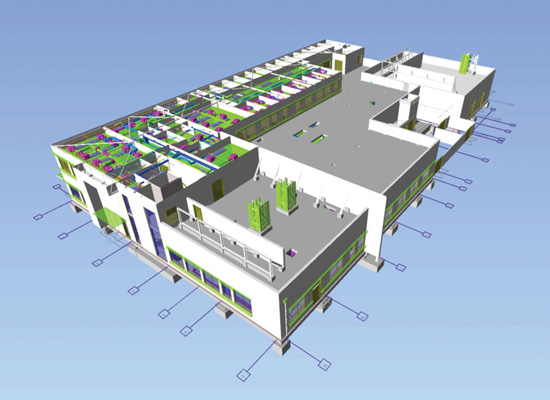
Image courtesy of The Design Büro
BIM is not the same as producing drawings with CAD; rather, BIM allows for a broader and more integrated design process with more and better information.
BIM is not the same as CAD just as constructing a cardboard model is not the same as doing a hand drawing. BIM offers a process that is different than CAD in that it uses designer-defined information to create buildings electronically, in effect, building them first within the virtual environment of BIM, not using just lines or simple objects. Beyond that, BIM has emerged as a genuine way to centralize and integrate all aspects of not only the design process but also the delivery of services, the creation of deliverables, and even the process of construction. By allowing the computer to do what it does best, namely organize information, and freeing up the architects and designers to do what they do best, namely create, assess, analyze, and synthesize all aspects of the design, the best of human and computer capabilities come together. This is not a theoretical view of computers and design; instead, it is being successfully done around the world today by a growing number of professionals who are indeed transforming themselves and the design professions.
Using BIM in the Earliest Design Stages
One of the common misconceptions among architects regarding BIM is a perceived need to wait to use it until a design is advanced and ready for construction documentation. To do so eliminates some of the best and creative aspects of BIM and denies its real time-saving potential. Instead, design can begin from the outset using BIM. This is possible because the fundamental tool used by computers is parametric design, meaning that parameters such as geometry, form, or other conditions determined by initial programming and feasibility data can be entered into the computer as design conditions. This can be done in words and numbers in addition to spatial guidelines and dimensions since computers bring new powers to designers to create their own parametric objects through what has become known as graphical scripting language. Based on these parameters, the computer can generate a 3D model consistent with all of the design inputs. This approach is also called generative design based on the ability to create or generate numerous options by changing one or more of the defined criteria or parameters of an initial design. In this way of working, design intent comes first while digital tools become the means through which an architect brings exploration and resolution to that design intent. Of course conceptual designs can be still be initiated with a basic model or even a hand sketch if preferred, which becomes the basis for the design parameters.
Part of the beauty of working with BIM from the outset is that it allows total flexibility when making design changes or alterations as a design is refined or as feedback is received. The process is streamlined since in a parametric environment, elements have a hierarchy and a relationship to other elements. That means changing the length of a wall for example, would update not only the wall but also any elements within it such as framing, windows, insulation, etc. In this way, BIM supports a real iterative design process, easily allowing changes in a model and leading to a progressively deeper and more comprehensive understanding of the building being designed. This streamlined approach is helpful since it is common for any design process to generate a lot of changes or alternatives at the beginning of the process and hopefully less as work continues. If cardboard models were being built or paper or CAD drawings were being prepared to look at all of these variations, it would be very time-consuming. But with BIM, a base model can be created and then saved as a separate file to create a variation, which can then be saved to produce another variation, etc. This process is much more time-efficient and allows solutions and variations to be produced and investigated rapidly. Using BIM at the outset also means that all of the variations and alternatives can be saved as separate files so each one can be captured, studied, and compared to the others.

Images courtesy of Nemetschek Vectorworks, Inc.
Using iterative modeling as the basis, BIM can be used at the very beginning of the design phase to look at fundamental massing and siting issues of a building.
The level of detail in an early design model is also completely definable. The model can focus on just the exterior shape and form just as a massing model or study model might have in traditional times. It can go a little deeper and look at the building envelope in terms of glazing and façade treatments. It can look at interior spatial volumes and areas as they relate to each other and define the flow of interior spaces. It can model existing conditions in a building renovation project. Specific areas of a building or project can be isolated and explored in greater detail if needed to inform the larger overall design. Hence, the design process remains fully personalized and fully adaptable to the size, scope, and criteria of the particular project. In short, anyone who values design should value the potential of BIM.
Designing for Sustainability and Performance
Another incredibly valuable aspect of BIM is the ability to run performance simulations of a particular building design or variation. The better the performance as determined by simulations, then the more sustainability that usually results in the final design. This is particularly true in terms of how a building can be expected to perform over its useful life, including how much energy is required to operate it. All building designs, new or renovation, are being driven to meet the challenge of reduced energy consumption and greater sustainability whether driven by large-scale environmental concerns, energy codes, or economic concerns by owners on the cost of energy. In response, designers who recognize and use this simulation capability can readily make sound decisions regarding the performance of a building in terms of things like energy usage, lighting, etc.

Image courtesy of François Lévy
A very valuable aspect of BIM is the ability to run performance simulations of a particular building design or variation, particularly for determining energy consumption comparisons. In this model, a stack-effect calculation has been integrated in BIM with a worksheet that responds dynamically to changes in aperture sizes and relative heights, automatically providing an updated airflow rate estimate.
According to the not-for-profit organization Architecture 2030, the largest impact on energy reduction comes about by the design of a building, not by adding technology. In particular, designs that acknowledge the influence of the natural site elements (sun, wind, weather, etc.) on the building's energy use patterns and use a building envelope (walls, roof, floor) to either allow or restrict those natural elements into the building can have huge impacts on energy use. BIM can play a key role in determining those impacts from the earliest design phases, as well. Simulated designs can be compared against performance standards such as the U.S. Green Building Council's LEED program, the ENERGY STAR for buildings program, or Passivhaus for residential design. Software, either within a BIM model or run separately, can account for the path of the sun, the annual weather / climate patterns, the amount of wind, and other onsite factors as they affect a building. Software can also account for the usage patterns, internal energy demands, and human factors that drive the need for energy for HVAC, lighting, or operations. Relying again on parametric design, a designer can alter a detail such as the window to wall ratio on a façade, change the orientation of a building on a site, or minimize the external surface area, and see the relative impact on energy usage each time because of that change. This information can then be used to make design decisions to optimize the building performance for energy usage while also informing other criteria for size, cost, or other factors.
François Lévy has built his Austin, Texas practice Lévy Kohlhaas Architecture around this marriage of BIM and sustainability. He describes his work as “buildings that capture the imagination, express regional beauty and a sense of place, and sit lightly on the earth.” His work investigates the intersection of design, technology, and sustainability with a particular passion about working collaboratively to create buildings that eloquently express how to use and conserve energy and water, and inhabit the land. Moreover, he asserts that “BIM offers architects a rich opportunity to validate qualitative design decisions with early quantitative analysis. When the 3D geometry and intelligence of BIM are at the service of sustainable design, architects can use green design goals as a fertile context to design buildings that are both beautiful and responsive to their climates.” Lévy's projects have attracted regional and national press, including HGTV, Dwell, This Old House, and Natural Home magazines. He has also authored a book titled BIM in Small-Scale Sustainable Design,2 which is unique in its clear procedures for designing sustainable, climate-load dominated buildings within a BIM workflow. As a resource for design professionals, the book addresses the latest technological tools in BIM, sustainable design, and integrated practice. It covers a range of topics including passive cooling and heating, building hydrology, optimizing material use, reducing construction waste, and collaboration within teams of building design professionals.

Image courtesy of François Lévy
Using BIM software tools, two competing design criteria of minimizing impact on the site while maximizing the shading effect and solar PV collection of the roof were studied in a series of simulations to determine the best sustainable performance outcome.
Lévy also advocates the leveraging of the quantitative information inherent to BIM to better inform the architect's qualitative design decisions. For example, he designed a residence on a 15-acre site in rural Texas, orienting the house on a dominant east-west axis to maximize solar gain control with a roof pitch and azimuth that are close to optimal for solar photovoltaic (PV) cells. A curved and formally expressive south-facing thermal chimney provides effective passive ventilation. The house's orientation, refined to allow all the nearby trees to thrive, coupled with a requirement of a step-less interior, was somewhat at odds with the site's topography: one end of the home was forced six feet above grade. Here, intelligent BIM software tools were used to support the architect in negotiating two competing agendas: minimizing impact on the site while maximizing the shading effect and solar PV collection of the roof. A series of simulations and BIM studies demonstrated how alternative orientations could be tested with the BIM software's intelligent site model tool and evaluated against a previously established ideal orientation from BIM solar animations. Ultimately, Lévy settled on a design that balanced site considerations and solar performance, informed by BIM's quantitative analysis capabilities.
Developing the Design with Others
So far, the focus has been on an architect or firm using BIM in the design process. One of the truly transformative aspects of computerized BIM, however, is full collaboration with all stakeholders in the design and construction of a building project. This is possible even if different software is being used among the various parties due to the establishment of Open BIM standards that allows for a common software methodology to transfer data between programs. The key, however, is the establishment of one entity that owns and maintains the master building information model. In a return to the Master Builder role, that entity should be the architect who oversees and coordinates the work of all others. From the designated master model, information can be transferred to others for creation of sub-models for the structural systems, the site, the Mechanical, Electrical, and Plumbing (MEP) systems, and even a separate model for the architectural portion of the work. Each discipline starts with the modeling equivalent of “baseline drawings” in which to develop one's own detailed portion of the work. The result is returned to the master model for coordination and adjustment as may be necessary or deemed desirable. As the design progresses, the relevant information and documentation can be extracted from the model for design iteration improvements, final detailing, coordination, and data updates.
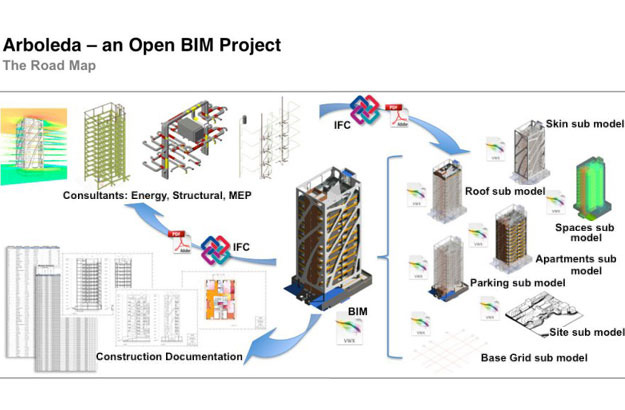

Images courtesy of Nemetschek Vectorworks, Inc.
Open BIM software standards allow a master model to be created while different members of a design team are able to use their own software to look at different aspects of structure, HVAC, heat loss, etc., which then relate back to the master model.
A fully integrated BIM process goes beyond the design team, however, and enables collaboration with the owner and construction professionals including contractors, construction managers, fabricators, sub-consultants, and suppliers. To the extent that all of these parties can be identified and brought to the table during design, then specific information related to particular products and materials can be directly inputted into the final model. The BIM process allows different manufactured items to be tested and assessed iteratively so that the best selection can be made as part of the final design. All of this means that the structure is literally being built on the computer, allowing actual product selections and ordering to take place in advance, thus saving time and overhead during the construction of the project. The specifications for these products and materials are embedded in the items used such that each component material, product, or system has corresponding information in the model related to features, attributes, size, quantity, and cost. This approach allows the computer to automatically generate schedules, materials lists, and pricing that can be seen and discussed by all to make fully informed, final decisions.
BIM During Construction
As a virtual building process, it is easy to see why construction professionals have embraced BIM more quickly than some architects. Three-dimensional visualization of the different systems in a building allows for constructability reviews to take place ahead of time rather than causing delays in the field while techniques are sorted out. Handling construction sequencing and details in the model means onsite workflows can be streamlined. BIM also allows for different systems to be checked for conflicts such as an HVAC duct that is located in the same place as a structural beam. Identifying and correcting conflicts like this on the model ahead of time eliminates a potential time delay and change order request during construction. BIM can also be used by the construction leader to tie directly into time schedules and construction costs by using information in the model to verify quantities and sequences that can be translated into time requirements and pricing finalization.
Perhaps one of the biggest benefits for everyone on the team in using BIM as the basis of design and construction is the streamlined flow of information between all parties. For example, one of the most time-consuming parts of traditional construction period services for design firms is the review of shop drawings and submittals. In a paper-based documentation project, this is the only way a designer can review particular fabrications, products, or materials that are being proposed by the contractor as meeting the drawings and specifications. Of course, these shop drawings are never accepted as a replacement to the construction documents, but they are the detailed basis of building systems such as steel fabrications, millwork, built-in equipment, cabinetry, etc. By contrast, a fully integrated BIM workflow has eliminated the need for shop drawings and submittals in many cases. With all parties involved in advance, the model incorporates the information that would otherwise be created as separate shop drawings.
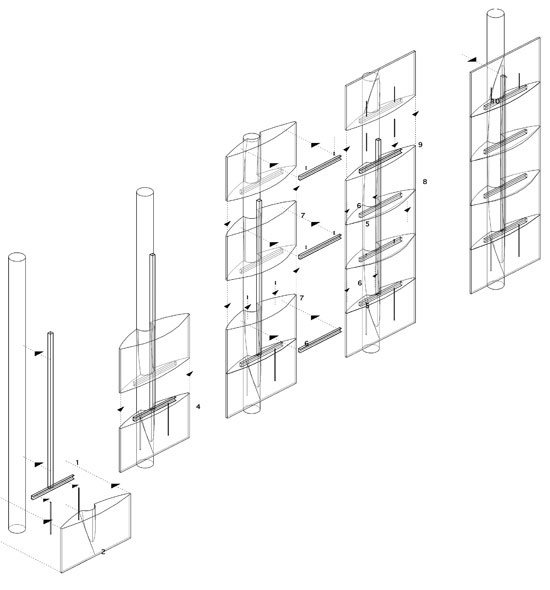
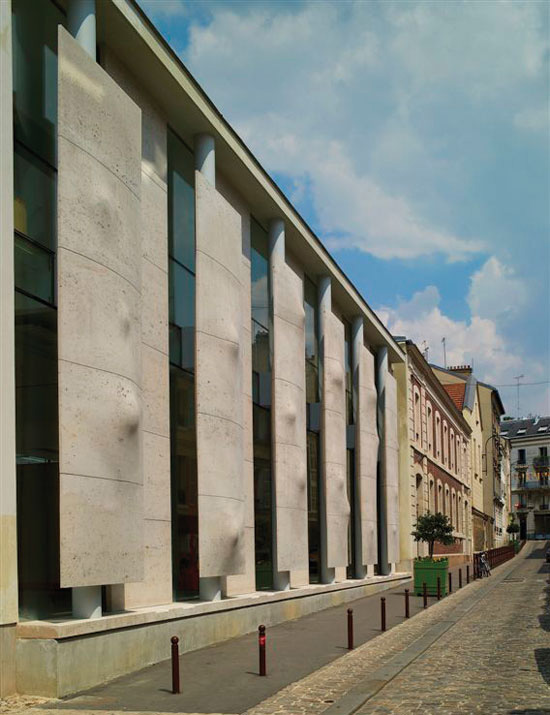
Images courtesy of Nemetschek Vectorworks, Inc.
The full BIM process constructs the building electronically in the model first, meaning that it already exists virtually, only needing to be actualized in the field.
Taking this one step further, a growing number of design firms incorporate either customized or standardized fabrication into their building designs to fully control some aspects of construction. Modular construction projects are one example where architects and other designers use BIM to create the particular modules that are fabricated and delivered to the site. This form of “digital fabrication” can apply to entire living units, to bathroom or kitchen cores, certain wall assemblies, or smaller components such as cabinetry and finish treatments. In this way, the architect is able to transmit data directly to a fabricator or sub-contractor for direct-to-manufacture processes, thus eliminating any opportunity for misinterpretation or substitutions. At this level, the architect can take control of the entire process by using BIM for design, fabrication, assembly, pricing, scheduling, and overall realization of the project. Architect, author, and educator Richard Garber sees this dramatic advance as the architect evolving out of the 20th century models of practice. He describes the former, traditional approach as going from “possible-to-real”, which relied on construction documents prepared by an architect to be specifically interpreted by a third party such as a general contractor and subcontractors. With BIM in 21st century practice, architects instead embark on a “virtual-to-actual” paradigm in which much interpretation is removed since key data has already been placed in the model. In this sense, a virtual model is already “real” in the computer, only needing to be “actualized” in the field to be made physical.
BIM and Professional Practice
The implications of all of the above aspects of BIM apply to buildings and practices of all sizes. In fact, it is easy to see that a collaborative BIM process allows smaller firms to compete by engaging with other team members electronically focused around a master model and working via the internet with anyone, anywhere. A BIM-focused team can produce very sophisticated designs and documentation without needing a large team of drafters or a lot of extra resources. For larger firms or those with multiple offices, it is easy to see how teams can quickly and easily collaborate and share information, allowing expertise from across the firm to be harnessed in the design without needing to physically move people from one place to another.
Firms that are embracing BIM are finding that it is not about the software or the computer; rather, it is all about a powerfully improved way to practice the process of providing design- and construction-phase services. The AIA has recognized this and now offers contracts that can be tailored as multi-party agreements to allow all parties to benefit financially from a successfully completed project and share more equally in that success. This holistic approach to design and construction that comes about through the BIM process is thus applied in the same manner to all of the stakeholders and the agreement for services.
The design and construction fields have experienced a change in staffing since BIM's emergence. Just as manufacturing in the United States has changed and requires more sophisticated, better educated, and more skilled workers than a generation ago, the same has been observed in the Architecture, Engineering, and Construction (AEC) industry. BIM has helped to alleviate some of the compartmentalization of responsibilities, meaning that there is less need for architects who are separate from designers who are separate from drafters. Rather, since the team is working more holistically, architects or designers may be inputting information directly into a master or architectural model, as well as collaborating to assess and review the outcomes of different iterations. That means that everyone needs to have an understanding of how to construct and design the project so that the information added into the model is relevant, timely, and appropriate to the overall building. At first, this may sound like it is increasing personnel costs, but in reality, it may reduce them by requiring fewer people, albeit with higher skill sets, and allowing the computer to maximize the efficiency of everyone's time.
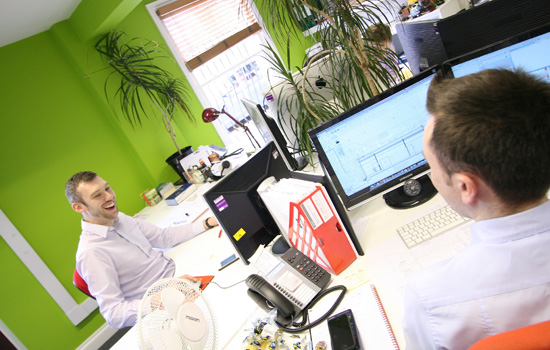
Photo courtesy of The Design Büro
The implications of BIM on architectural practice are transformative, allowing greater collaboration by designers with more skills and understanding of the construction process, as well.
Design firms can learn some lessons from construction professionals who were the earliest adopters of BIM over any other group in the AEC industry. This is likely because in the real world, contractors recognized huge benefits from using BIM, specifically benefits of saving money and saving time. Contractors have been and still are taking architects' 2D drawings and creating their own building information model from it. That model becomes the tool that they use to first create the building electronically and then in actuality. Design firms can reap the same benefits of time and money savings while receiving the added benefit of enhancing their own design process to develop and create buildings or components that may not have been thought of or been possible before. Further, by retaining control of the master model for a project, the design firm now becomes a long-term partner with the building owner and can continue the working relationship to help with managing the facilities, and monitoring and improving performance. As the need for future alterations, additions, or renovations develop, the master model is in place and up-to-date, allowing for automatic opportunities to design and construct those future needs. The design firm can therefore provide broader services to existing clients and establish a basis for repeat business together.
Conclusion
A growing number of design professionals, firms, and organizations are embracing BIM because it provides a more holistic, integrated approach to design and construction. If thought of in this way, BIM is not disruptive but rather transformative in the way designs are developed, services are provided, and buildings are constructed or renovated. BIM provides tools for architects and other design professionals to quickly understand and improve their designs. This allows better design decisions to be made earlier and more efficiently than prior work processes that relied on 2D drawings or hand-built models. It also allows for revisions or alternatives to be prepared more quickly and easily.
As a process that is inherently iterative, BIM's greatest benefits are realized if it is implemented from the earliest stages of design so different options can be explored and understood more robustly without wasting time or staff resources. If improperly implemented, then people may use different processes to accomplish different tasks and then simply pass the work along to the next person who has to redesign it. However, if properly implemented around a master model that can be the basis for everyone's work, then there's nothing wrong with using different methods, materials, or even specialty software throughout the process, provided all of them can communicate with each other.
From a project management standpoint, BIM is more predictable. With more and better information tied into the model and the people working on it, it is possible to know the cost of a design, as well as the cost of construction earlier and more accurately. Overall, BIM is about managing change, managing opportunities, and managing possibilities for even the most creative endeavors.
Endnotes
- BIM Design – Realising the Creative Potential of Building Information Modelling, by Richard Garber, © 2014 John Wiley & Sons Ltd., London.
- BIM in Small Scale Sustainable Design, by François Lévy, © 2012 John Wiley & Sons Inc., New York.
 |
Vectorworks Inc.
Vectorworks, Inc. is the developer of Vectorworks software, a line of industry-specific CAD and BIM solutions that help more than half a million design visionaries transform the world.
www.vectorworks.net |






